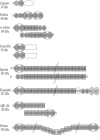The Arabidopsis cytoskeletal genome
- PMID: 22303225
- PMCID: PMC3243305
- DOI: 10.1199/tab.0096
The Arabidopsis cytoskeletal genome
Abstract
In the past decade the first Arabidopsis genes encoding cytoskeletal proteins were identified. A few dozen genes in the actin and tubulin cytoskeletal systems have been characterized thoroughly, including gene families encoding actins, profilins, actin depolymerizing factors, α-tubulins, and β-tubulins. Conventional molecular genetics have shown these family members to be differentially expressed at the temporal and spatial levels with an ancient split separating those genes expressed in vegetative tissues from those expressed in reproductive tissues. A few members of other cytoskeletal gene families have also been partially characterized, including an actin-related protein, annexins, fimbrins, kinesins, myosins, and villins. In the year 2001 the Arabidopsis genome sequence was completed. Based on sequence homology with well-characterized animal, fungal, and protist sequences, we find candidate cytoskeletal genes in the Arabidopsis database: more than 150 actin-binding proteins (ABPs), including monomer binding, capping, cross-linking, attachment, and motor proteins; more than 200 microtubule-associated proteins (MAPs); and, surprisingly, 10 to 40 potential intermediate filament (IF) proteins. Most of these sequences are uncharacterized and were not identified as related to cytoskeletal proteins. Several Arabidopsis ABPs, MAPs, and IF proteins are represented by individual genes and most were represented as as small gene families. However, several classes of cytoskeletal genes including myosin, eEF1α, CLIP, tea1, and kinesin are part of large gene families with 20 to 70 potential gene members each. This treasure trove of data provides an unprecedented opportunity to make rapid advances in understanding the complex plant cytoskeletal proteome. However, the functional analysis of these proposed cytoskeletal proteins and their mutants will require detailed analysis at the cell biological, molecular genetic, and biochemical levels. New approaches will be needed to move more efficiently and rapidly from this mass of DNA sequence to functional studies on cytoskeletal proteins.
Keywords: actin-binding proteins; intermediate filaments; kinesin; microfilaments; microtubule-binding proteins; myosin; plant proteome; tubulin.
Figures



References
-
- Adams J, Kelso R, Cooley L. The kelch repeat superfamily of proteins: propellers of cell function. Trends Cell Biol. 2000;102(1)(1):17–24. - PubMed
-
- Altschul SF, Gish W, Miller W, Myers EW, Lipman DJ. Basic local alignment search tool. J Mol Biol. 1990;2152(3)(1):403–10. - PubMed
-
- Amos LA. Focusing-in on microtubules. Curr Opin Struct Biol. 2000;102(2)(1):236–41. - PubMed
-
- An Y-Q, McDowell JM, Huang S, McKinney EC, Chambliss S, Meagher RB. Strong, constitutive expression of the Arabidopsis ACT2/ACT8 actin subclass in vegetative tissues. Plant J. 1996;102(1):107–121. - PubMed
Grants and funding
LinkOut - more resources
Full Text Sources
Miscellaneous
